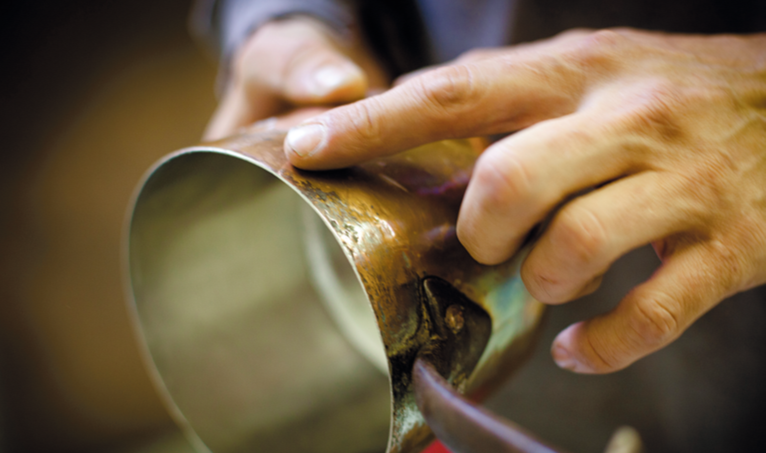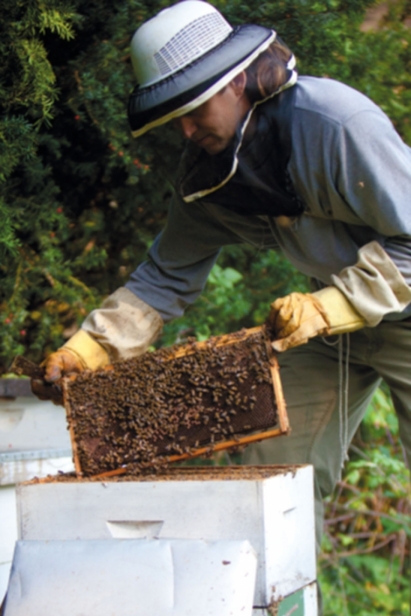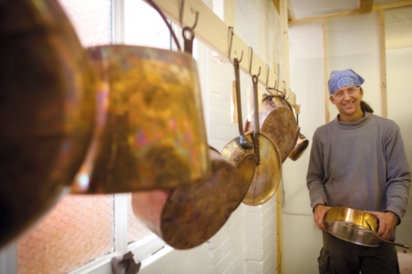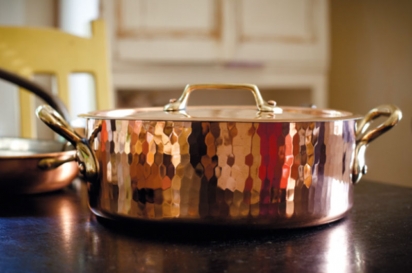By Hand: Beekeeper Jim Hamann Finds a Love for Copper Pots
Jim Hamann is a lucky guy. He has been able to turn a hobby and a passion into a livelihood. The single father of two sets of twins—15-year-old boys and 17- year-old girls—gave up a career in sales and marketing to devote more time to them. Plus, he gets to wear a ponytail and rumpled jeans while working out of a “small house with a rich environment.”
Jim is a part-time beekeeper with four to five hives that sit about 10 feet from two well-used Adirondack chairs in a small backyard in the historic Hill district of East Greenwich. The hives produce about 150 pounds of honey every year, which he bottles himself in a commercial kitchen. Most of his supply is sold at Farmstead in Providence under the eponymous brand name J. B. Hamann. And some of it is given to neighbors “to sweeten the pot.”
The bees gather nectar from nearby locust and basswood trees and the flavor of the honey varies according to the season. In early June and July the nectar is light and floral, becoming rich and dark red from local knotweed in September. “That one is really spectacular,” says Jim. He became interested in beekeeping about 11 years ago when a friend introduced him to the lowmaintenance hobby.
Low-maintenance but sometimes painful. Jim says he gets stung all the time, even though he works the hives in protective clothing. “You get used to it after a while.”
As the owner of East Coast Tinning he is gaining a reputation for a unique skill: turning old copper cooking pots and pans into gleaming beauties. Copper pots, beloved by chefs and serious home cooks, are a kitchen luxury. They’re usually seen hanging from designer kitchen pot racks in the pages of home decorating magazines. But surprisingly, there are lots of people who treasure their old copperware. Every day these nicked and dented pieces arrive at Jim’s door, looking like muddy old pennies, their tin linings worn away and their interiors rusty from wear. When he ships them back to their grateful owners two weeks later, they look as if they’ve come new, directly from a fine kitchen store.
Part of the charm for Jim is that every pot comes with a story. They are stacked on his dining room table. This one was left to a 20- something by his grandmother; that one is a two-quart sauté pan from the Waldorf Astoria kitchens in New York City. Jim points out the nicks along the top edge made by years of spoon tapping. A New Jersey homeowner sent a dozen pans that had corroded from seawater during Hurricane Sandy.
As he goes through the retinning process Jim imagines the people who used these kitchen treasures and those who ate the food that was cooked in them.
“You straightened out the rim and polished up the surface without sacrificing any of the character that the piece garnered over the last hundred years,” wrote a satisfied Florida customer. “I have several modern pieces but this pan tops them all in its beauty and the memories it invokes of my mom and her kitchen.”
Jim came to appreciate copper pots during a trip to France in 2004. In an antique shop in Saulieu in Burgundy, he found a huge copper stockpot with brass handles. It came from renowned La Cote d’Or, a Michelin three-star restaurant whose storied proprietor had committed suicide over the loss of a star the year before. The dark, rusty pot cost $80 and probably was doomed to life as a planter. “I took one look at it and I had to buy it,” recalls Jim. Today, retinned and revived, the pot sits on his kitchen shelf when it’s not in use.
But copper pots represent more than nostalgia. Copper provides a smooth, even heat. Food doesn’t stick, burn or overcook. Every part of the dish is cooked evenly, says Jim. It’s especially useful for home cooks who don’t have to prepare food restaurant-style—that is, very hot and very fast. Rollie Wessen, an instructor in the College of Culinary Arts at Johnson & Wales University, agrees that copper is the best conductor of heat. “A nicely made stainless steel pot has a copper layer; without it, it would develop hot spots pretty quickly.” But he admits that because of cost and upkeep, few restaurants rely on copper pots anymore—“unless they are at the very top end or three-star places that have teams of workers taking care of them.” In those celebrity restaurants the kitchen is often on display and copper pots add a touch of showmanship, says Rollie.
Heavy-gauge aluminum pots are more frequently used in professional kitchens. But they’re not practical for home cooks because, unless they’re used constantly, the aluminum oxidizes from moisture in the air and gives off a substance that turns food black.
The son-in-law of renowned chef Jacques Pepin, Rollie has a wall of copper pots in his own kitchen, many of them gifts from Pepin. He doesn’t use them every day, but says that copper pots “are beautiful and they have a place in history.”
Hamann revels in the beauty he is able to restore—what he calls the art and poetry of the pot. He begins the retinning process by removing the old tin lining with brushes and light sanding. He then applies pencilsized sticks of molten tin by hand. The last step is hand polishing the copper exterior to a gleaming tawny orange color.
Over time the soft tin lining of a copper pot wears away when it’s scrubbed with abrasives. When acid foods come in direct contact with copper, the metal turns an unappealing greenish color. The best way to remove burned food from a tin-lined pot is to fill it with hot water and a drop of dishwashing liquid.
An average retinning costs about $75. “It’s such a useable restoration,” says Jim. “You could have a pan worth $400 for just over $100.” He recommends polishing the copper with a paste made of ½ cup of white vinegar, 1 tablespoon salt and 3 tablespoons flour, or enough to make a thin paste.
In August 2013 East Coast Tinning moved from cottage industry to office, shop and showroom in a mill building overlooking Greenwich Cove. Here, in a 19th-century workspace, Jim crafts his own custom copper sauté pans in sizes including 8, 11¼ and 12½ inches in diameter. They are wrapped in burlap coffee bags and shipped in cedar boxes he makes himself. His work is found in Rhode Island restaurants: Diners who order chocolate soufflé at the Ocean House in Watch Hill spoon theirs out of his copper custard cups decorated with cast-iron loop handles.
Jim still seems surprised that what began as a garage startup a year ago has found a large niche market. He admits that it couldn’t have happened without modern technology— a website, Facebook and Twitter. But Claudine Pepin Wessen, who met Jim at the Newport Mansions Food and Wine Festival last year, says he is a classic Rhode Island craftsman from another era. “His work is to be admired.”
Gloria De Paola is a freelance writer and enthusiastic cook who has begun scouring antique shops and flea markets for worn copper pots. Score so far: a two-quart saucepan and a single-egg fry pan. Winning!
For more information visit East Coast Tinning at EastCoastTinning.com.










